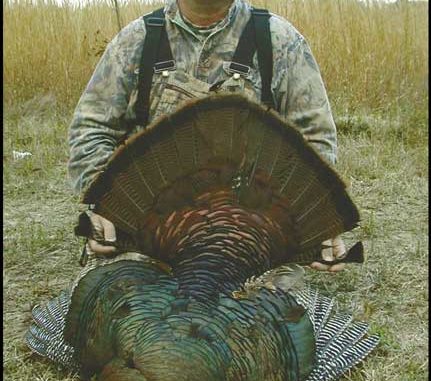
Discovering longbeards’ daily travel patterns can give hunters a big advantage.
Charles Grantham is no rural mail carrier, but he knows where most of the “tenants” live on the thousand or so acres that make up Lynches River Outfitters near Friendfield in Florence County.
Even though there are no mail boxes, Grantham keeps tabs on several different “addresses” where he can expect to find his buddies Puff Daddy, Capt. Hook, Paint Brush and Capt. Blackbeard.
* In the creek bottom at daylight;
* In the beanfield at 10:30 a.m.;
* Crossing this or that logging road at noon;
* Walking a ridge in a creek swamp at 3 p.m.;
* Crossing through planted pines at 6 p.m.;
* Back in the creek bottom by dusk.
Those are the kinds of rounds that the gobblers that live on Grantham’s little section of heaven make on a daily basis.
Since his primary springtime occupation is guiding turkey hunters, it pays Grantham to know where his gobblers are going to be — and when.
Clearly, it’s not just a crack-of-dawn kind of deal for the 21-year-old Grantham, who treats turkeys with a 24/7 fervor in the spring — well, maybe just a 12/7 fervor.
From dawn until dusk, Grantham makes it a priority to keep abreast of the movements of the dozens of gobblers that call his immediate zip code home.
And that’s a lesson from which hunters across South Carolina can learn: turkeys have a regular routine; figure it out and you’ve given yourself a leg up on filling your tags this month.
“It’s a matter of knowing your property and patterning the birds,” said Grantham, who operates Lynches River Outfitters (843-206-5171) and guides along with Michael Floyd and Brandon Sapp. “Sometimes, if you know your land well enough, you don’t even have to call. Scouting will tell you when and where to set up on a bird, and then, you just have to be patient.”
At just about any time during the month-long spring season, Grantham has got the daily routines of about a half-dozen or so gobblers committed to memory. If a bird outmaneuvers him coming off the roost, he’s got a pretty good idea where that gobbler might show up around 10 a.m., when his early-morning girlfriend has lost interest. It’s just a matter of getting there, settling down and not making a mistake — and even then, that’s not always enough.
Grantham may come back to a bird two or three times in a day’s hunt, and he may switch gears if a gobbler gives him the slip, turning his attention to another bird that regularly shows up at another place and time.
Scouting for a lot of South Carolina hunters consists of a few early mornings in the woods or afield, listening for birds to gobble on the roost, and maybe a stroll through a tract of land, looking for tracks on sand or dirty roads, and maybe spying a dusting area or strutting zone.
That doesn’t even begin to scratch the surface for Grantham. He spends several hours a day, several weeks before Opening Day, tracking the movements of gobblers, jakes and hens. He rides logging roads and farm roads in a golf cart, binoculars at the ready to check agricultural fields, power lines and the open swamp bottom for gobblers.
If he sees a gobbler in a certain area at a certain time one day, he’ll check back the next couple of days to see if the bird is using the same area at roughly the same time. From there, his knowledge of the land he’s hunting can point him to the possible places the turkey had been earlier and might head later in the day.
“I come out about every day the month before the season and sit a couple of hours in the morning — until they come off the roost — then I watch fields with binoculars,” Grantham said. “When they get on the ground, you need to have their movements patterned.
“From March to April, they change their patterns so much — they change places and go to different spots. They may start roosting over a little creek instead of out over the river. They are more territorial to their roosting areas in the morning and in the afternoon. You have to figure that out.”
Last spring, after a turkey that was gobbling lustfully from its roost over a flooded swamp bottom had turned down the sweet yelps and clucks from Grantham’s slate call, he made a circuitous walk around a big patch of woods and across a field, headed to a makeshift blind that was struck just inside another patch of woods. Within 30 minutes, a huge gobbler was on his approach, 75 yards away, when a flock of a half-dozen jakes raced in, surrounded him and ran him off into the swamp, taking turns attacking his flanks.
An hour later, after a breakfast break, Grantham headed two more places looking for birds that had left the hens with which they roosted. “There’s a gobbler that’s been coming into this field about 12:15 every day,” he said as he rounded the corner on a logging road.
The turkey must not have gotten his itinerary correct, because around the corner, 200 yards away, the gobbler had just slipped out of the woods 10 minutes early and was picking along the edge of the field, looking for seeds, insects or perhaps just some gravel for its craw.
That brought about a shift to another gobbler, one Grantham said he expected to walk a north-south ridge and come out along the edge of another field in mid-afternoon. The bird did exactly that, but he came in silently, seeing Grantham and his hunter before shotguns could be brought to bear on him.
After a late-afternoon ride along the edge of the Lynches River swamp bottom to look and listen for gobblers to hunt the next morning, Grantham suggested intercepting gobblers that had been working one edge of the property on a regular basis as they headed toward another swamp bottom to roost. This time, Grantham saw the gobblers first, easing along a fenceline on the edge of a broomstraw field, and he got his hunter hidden in time. The result was a 19-1/2-pound gobbler with a beard that measured well over 11 inches, plus 1-1/8-inch spurs.
“What I try to do is have them patterned on the roost, in mid-morning, in the afternoon, and when they come back to roost,” Grantham said. “We just try to stay in front of him. That’s where having your birds patterned and knowing your property helps. You can figure out where they’re going to go.”
As a general rule, Grantham said that his gobblers roost over water in either a creekbottom, a riverbottom or a low, swampy area. They get up with a hen after they fly down, spend a couple of hours with her, then go on their way.
“They may come out and strut a little bit if they’re really hot, but they hang out in the bottoms in the middle of the day until they come out and scatter out in the fields to look for worms, bugs or grass seeds. I guess they get hungry and want to get back out in the fields,” he said. “If it’s windy, they’ll get out of the woods, because their vision gets blurry and they can’t see predators as well. Sometimes they’ll get out in the middle of the day or early afternoon and dust, and they like plowed or disked fields for that. They’ll feed a little; I think they want a little energy before they go to their roost.”
Like a lot of hunters, Grantham thinks locating a bird on the roost is as good an opportunity as he’ll get all day. He uses a locator call — an owl hooter — to try and get birds to gobble at dusk after they’ve flown up to roost or when they’re getting ready to. If he can pinpoint a bird — if he can see him silhouetted in the branches of a tall roost tree — he’ll set up as close as possible the next morning.
The one exception, Sapp says, is if he locates a late-afternoon bird that’s already gotten with a hen.
“If you go in the afternoon and see a gobbler and a hen together, if you call and he answers and struts but makes no effort to come to you, he’s not going to leave that hen,” Sapp said. “I’ll go ahead and sleep in the next morning, then hunt later, because he’s going to be out looking for you after that hen goes to the nest.”
Floyd wants to know where a gobbler is going to be when he comes off the roost, and where he’s going to show up around 2 in the afternoon.
“My favorite time is in the morning, when the gobbler is still in the tree,” he said. “He’s giving away his location, and he’s giving you ample opportunity to set up on him, to put out decoys and talk to him a few times to let him know you’re there — but don’t overdo it. But if a gobbler is with a hen, then I’ll call more aggressively.
“I want to give him 100 percent until about 9 o’clock, then from about 2 o’clock until dust. If you know where the hens are nesting, he’s going to follow them in there (in the morning) before he leaves them.”
Because he can predict the general areas where gobblers will use — they tend to walk the same trails year after year, Grantham builds a lot of blinds, sometimes from natural materials, sometimes using camouflage netting. He likes to leave them in the woods through the offseason. If his blind is along a field edge, he’ll usually leave a couple of hen decoys so he can quickly set them up out in the open where a gobbler will see them. The tom may approach the decoys, but just as important, he’ll often overlook hunters in a blind while concentrating on the fake female.
“I want to put my blinds up a year in advance so they birds are used to seeing them,” he said. “They blend in; you get some undergrowth growing up around them — the little trees you leave, that kind of stuff.
“Gobblers do have the same travel routes year after year,” he said. “They’ll feed and funnel about the same places every year unless something changes or there’s something different.
“And different birds will use the same funnels and fields to feed, but at different times of the day.”

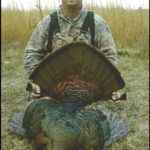
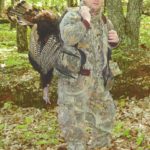
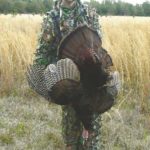
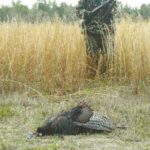



Be the first to comment